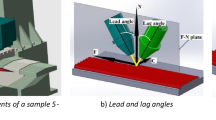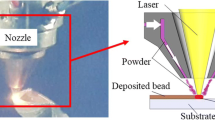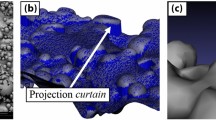Abstract
Using multi-axis tool paths in combination with a structured segmentation strategy introduces novel fabrication solutions for the direct energy deposition additive manufacturing process. However, with a piecemeal manufacturing strategy, interface regions are introduced. The goal of this research is to determine whether utilizing a multi-stage, multi-axis build strategy has an impact on the resulting hardness characteristics within the component. Surface roughness variations are noticeable when using a partitioning approach, so it is expected that hardness variations will result. The case studies consist of fabricating a set of thin wall (2 mm) hemispheres or domes. Two 45-mm nominal diameter domes are built using a wedge-based partitioning strategy. A 60-mm-diameter dome is fabricated using a rotary tool path approach. Various data collection strategies are investigated, and 300 gf or 1000 gf is recommended for the setup. It is found that the hardness across the bead thickness does not vary greatly at any point, but the hardness varies along the thin wall as the bead builds up. The interface zones have distinctly different hardness values, and the pattern is repeatable. Using fast Fourier transforms, the frequency of the noticeable surface roughness and hardness variation aligns to the interface boundary regions. This experiment illustrates that novel build solutions can be employed to eliminate the necessity of supports, but resolving a geometry issue may introduce physical and mechanical property variations within a component.





































Similar content being viewed by others
Data Availability
Not applicable
Code availability
Not applicable
References
Du K, Qu WY, Jing YH, Zhu Q (Jan. 2019) Application of the correlation between hardness and strength in conventional Al alloys into semi solid processed products. Solid State Phenom 285:99–104
Brooks I, Lin P, Palumbo G, Hibbard GD, Erb U (2008) Analysis of hardness–tensile strength relationships for electroformed nanocrystalline materials. Mater Sci Eng A Struct Mater 491(1):412–419
Khodabakhshi F, Haghshenas M, Eskandari H, Koohbor B (2015) Hardness−strength relationships in fine and ultra-fine grained metals processed through constrained groove pressing. Mater Sci Eng A Struct Mater 636:331–339
Sandomirskii SG (2017) Estimation of the ultimate tensile strength of steel from its HB and HV hardness numbers and coercive force. Russian Metallurgy (Metally) 2017(11):989–993
H. Konrad, “The Fundamentals of Hardness Testing,” in Hardness Testing Principles and Applications, ASM International, 2011.
Saqib S (2016) Experimental investigation of laser cladding bead morphology and process parameter relationship for additive manufacturing process characterization. University of Windsor
Strano G, Hao L, Everson RM, Evans KE (2013) A new approach to the design and optimisation of support structures in additive manufacturing. Int J Adv Manuf Technol 66(9):1247–1254
Vanek J, Galicia JAG, Benes B (2014) Clever support: efficient support structure generation for digital fabrication. Comput Graph Forum 33(5):117–125
Maskery I et al (2018) Insights into the mechanical properties of several triply periodic minimal surface lattice structures made by polymer additive manufacturing. Polymer (Guildf) 152:62–71
ASTM F2792-12a, “Standard terminology for additive manufacturing technologies.”
Ghosal P, Majumder MC, Chattopadhyay A (2018) Study on direct laser metal deposition. Mater Today Proc 5(5):12509–12518
Lewis G (1995) Direct laser metal deposition process fabricates near-net-shape components rapidly. Mater Technol 10(3–4):51–54
M. R. Modupe, A. E. Titilayo, and A. S. Akinwale, “Laser additive manufacturing.” IGI Global, p. 1, 2016.
Zhang K, Wang S, Liu W, Long R (2014) Effects of substrate preheating on the thin-wall part built by laser metal deposition shaping. Appl Surf Sci 317:839–855
Huang FX, Jiang ZH, Liu XM, Lian JS, Chen L (2011) Effects of process parameters on microstructure and hardness of layers by laser cladding. ISIJ Int 51(3):441–447
Saboori A, Gallo D, Biamino S, Fino P, Lombardi M (2017) An overview of additive manufacturing of titanium components by directed energy deposition: msicrostructure and mechanical properties. Appl Sci 7(9):883
Zareh P, Urbanic RJ (2020) Experimental analysis of single layer multi-track deposition of clad beads with variable overlap percentages. Int J Adv Manuf Technol 109(5–6):1511–1525
Baek GY, Lee KY, Park SH, Shim DS (2017) Effects of substrate preheating during direct energy deposition on microstructure, hardness, tensile strength, and notch toughness. Met Mater Int 23(6):1204–1215
Long R-S, Sun S-N, Lian Z-S (2016) Crack restriction mechanism of thin wall metal parts fabricated by laser direct deposition shaping. Mater Sci Technol 32(6):523–539
Javidani M, Arreguin-Zavala J, Danovitch J, Tian Y, Brochu M (2017) Additive manufacturing of AlSi10Mg alloy using direct energy deposition: microstructure and hardness characterization. J Therm Spray Technol 26(4):587–597
Wang Q, Zhang S, Zhang CH, Wu CL, Ren L, Wang JQ, Chen J (2018) Functionally graded stainless steel fabricated by direct laser deposition: anisotropy of mechanical properties and hardness. Acta Metall Sin (English Lett) 31(1):19–26
Shim DS, Baek GY, Seo JS, Shin GY, Kim KP, Lee KY (2016) Effect of layer thickness setting on deposition characteristics in direct energy deposition (DED) process. Opt Laser Technol 86:69–78
“Standard Test Method for Microindentation Hardness of Materials,” in ASTM Handbook Designation: E384-17, 2017, pp. 1–40.
Sundararajan G (2001) “Hardness testing,” in Encyclopedia of Materials: Science and Technology 2st Edition, pp. 3728–3736.
Kalami H (2020) Supportless fabrication, experimental, and numerical analysis of the physical properties for a thin-walled hemisphere. University of Windsor
Saqib SM, Urbanic RJ (2017) Investigation of the transient characteristics for laser cladding beads using 420 stainless steel powder. J Manuf Sci Eng Trans ASME 139(8):1–12
Acknowledgments
This research is partially funded by the MITACs Accelerate Internship program. Special thanks to CAMUFACTURING Solutions, Inc. especially the president Bob Hedrick for partial funding, technical support and use of their APLUS software to create the toolpaths. Also, Thanks to Lincoln laser Solutions for sharing their facilities.
Funding
This research was funded by Mitacs Accelerate. Award number: IT12867. Grant recipients: Dr. Jill Urbanic, Dr. Mehrdad Saif
Author information
Authors and Affiliations
Contributions
HK: Design of the experiments, data collection and analysis, paper write up.
RJU: Data analysis, paper write up, project support
Corresponding author
Ethics declarations
Ethics approval
The manuscript is not submitted to any other journal simultaneously. The manuscript will not be submitted elsewhere until the editorial process is completed. The submitted work is original. A single study “Hardness Variations for Additive Manufactured Thin-Walled Components Built by Multi-Axis Tool Paths” is not be split up into several parts to increase the quantity of submissions. There is not any content being translated from other journals in other languages. Results are presented clearly, honestly, and without fabrication, falsification or inappropriate data manipulation. No data, text, or theories by others are presented as if they were the author’s own (“plagiarism”). The authors have permission to use the applied software. This research has not been applied to pose a threat to public health or national security.
Consent to participate
Not applicable
Consent for publication
All authors consent to publish the paper in the current order. The authors transfer to Springer the non-exclusive publication rights.
Conflict of interest
The authors declare that they have no conflict of interest.
Additional information
Publisher’s note
Springer Nature remains neutral with regard to jurisdictional claims in published maps and institutional affiliations.
Rights and permissions
About this article
Cite this article
Kalami, H., Urbanic, J. Exploration of hardness variations for additive manufactured thin-walled components built by multi-axis tool paths. Int J Adv Manuf Technol 113, 2209–2226 (2021). https://doi.org/10.1007/s00170-021-06724-0
Received:
Accepted:
Published:
Issue Date:
DOI: https://doi.org/10.1007/s00170-021-06724-0




